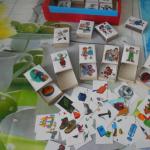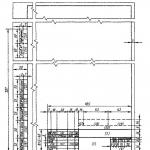Metallurgical complex non-ferrous metallurgy presentation. Presentation "ferrous metallurgy". or cast iron produced

- form an idea of the metallurgical complex;
- learn to establish connections between technical and economic features and factors of location of industry enterprises

Industry products –
foundation for the development of other industries.
Production of iron and steel.
In terms of production of ferrous metals, Russia ranks
4th place in the world.

Huge amounts of raw materials required
iron ore
manganese ore
coking coal
Huge volumes of water required

A large number of waste - waste
"dirty" production.


Concentration of production.
Very large volume of raw materials used
Large numbers
workers
A large number of
manufactured products

Combination
production.


Conversion plants
metallurgy
Enterprises
with electrometallurgical
production
There is no iron smelting stage;
scrap metal can serve as raw material
or cast iron produced
at other enterprises
In electric ovens without use
coal, bypassing the iron smelting stage,
smelting steel

IRON - most common chemical element
- The share of iron in the earth's crust is 4%
- Melting point - 1540˚С
- Properties: plasticity, magnetism
IRON ALLOYS
CAST IRON STEEL
Fe+C Fe+C
(C from 2 to 6.5%) (C to 2%)

The location of metallurgical enterprises is influenced by:
- Raw material
- Fuel
- Consumer
- Water
- Transport
- Ecological

ENTERPRISE TYPE
Full cycle plants
ACCOMMODATION FACTOR
1.Raw materials (near iron ore deposits or
at fuel sources)
2. Transport (between areas of raw materials and fuel extraction)
Pipe metallurgy plants
CENTERS
Lipetsk, Serov, Nizhny Tagil, Magnitogorsk, Novotroitsk, Novokuznetsk, Cherepovets
1. Raw materials (at sources of secondary raw materials in large engineering centers)
2. Consumer
Small metallurgy (rolled steel)
Raw materials (at sources of secondary raw materials)
Electrometallurgy
Moscow, Elektrostal, Nizhny Novgorod, Krasny Sulin, Taganrog, Volgograd,
Komsomolsk-on-Amur
Large foundries machine-building plants
Energy
Stary Oskol


Kosogorsky
Iron and Steel Works
Novotulsky
Iron and Steel Works
Metallurgical complex. Ferrous metallurgy. Compiled by a geography teacher MOBU SOSH LGO s. Ruzhino Mazur E.V.

The purpose of the lesson : to form students’ ideas about the metallurgical complex of Russia.
Tasks:
To familiarize students with the structure of the country's metallurgical complex.
To develop knowledge about metallurgical bases, types of metallurgical enterprises and factors of their location.
Continue developing the ability to compose a characteristic of an object using atlas maps.

Composition of the complex
Metallurgical complex
Ferrous metallurgy
Non-ferrous metallurgy (10%)
Iron production
and its alloys
Production of light metals ( Al, Ti, Mg)
Production heavy metals ( Cu, Zn, Pb)
Production of precious metals ( Ag, Au)
Production of alloying metals ( W, Mo, Vn)

Metallurgical complex is a set of industries producing a variety of metals.

Iron and steel production
Rolled products production
Melting steel
Iron ore mining
Oboga-
swearing
ore
Iron smelting

The basis of ferrous metallurgy
(full cycle plant)
Blast furnace shop
Steel shop
Rolling shop

Ferrous metallurgy enterprises: 1. Full cycle metallurgical plants (combines) 2. Pipe metallurgical plants 3. Small metallurgical plants

Features of the metallurgical complex
1. Full cycle metallurgical plants placed near raw materials or fuel or on ore and fuel streams
2. Conversion plants and small metallurgy plants They focus on scrap metal (waste from machine-building factories), therefore they are located in large cities, focusing on the consumer.
3. Metallurgical plant - This is a water-intensive enterprise, so it is built near a large river, lake or pond.
4. Metallurgy – a “dirty” industry, so you can’t build several metallurgical plants in one city.
5. Metallurgical plant can't work without railway, because The flows of raw materials and fuel are very huge.

A cluster of metallurgical plants that use a common ore or fuel base and produce the base metal of a country is called metallurgical base. There are 3 main metallurgical bases in Russia: 1. Ural 2. Central 3. Siberian


- Indicate the sources of raw materials and fuel for ferrous metallurgy.
- Indicate the largest metallurgical centers of ferrous metallurgy.
- Draw conclusions about the features of each base.

Central base – 44%
Raw materials – ores of the KMA, Kola Peninsula.
Fuel – coking coal of the Pechora basin, Donbass.
Centers:
- Tula (full cycle)
- Lipetsk (half cycle)
- Moscow (transferM)
- Elektrostal (before)
- Stary Oskol (electrometallurgy)
- Cherepovets (full cycle)
Ural base – 42%
(oldest)
Raw materials – ores of the Urals, KMA, Kazakhstan
Fuel – Kuzbass coal
Centers:
- Nizhny Tagil
- Chelyabinsk
- Magnitogorsk
- Novotroitsk
Siberian base – 13%
Raw materials - ores of Gornaya Shoria, Khakassia, Angaro-Ilim deposits
Fuel - Kuzbass coal
Centers:
- Novokuznetsk (full cycle)
- Novosibirsk (before)
- Krasnoyarsk (before)
- Petrovsk-Zabaikalsky

- What industries are part of the metallurgical complex?
- Name the metallurgical bases in Russia.
- Indicate the connections between raw materials and fuel.
- List the features of metallurgy.
- What types of metallurgical enterprises are there in Russia?
- What are the prospects for the development of the industry?

Homework: § 10, on the contour map, mark 3 metallurgical bases, indicate deposits of ore, coal and large metallurgical plants.
We start the topic with a problem. During the lesson we solve the problem. Introduction to the branches of metallurgy: ferrous and non-ferrous. Composition and importance of the industry. Practical work: identify the centers of metallurgical plants. Concepts - metallurgical plant, metallurgical base. Industry problems and development prospects.
Download:
Preview:
To use presentation previews, create a Google account and log in to it: https://accounts.google.com
Slide captions:
Metallurgical complex A set of enterprises for the extraction of ores and the production of metals 04/28/17 Bogutskaya Galina Sergeevna
The problem is waiting for your solution. To ensure supplies of oil and gas to Europe, more than 100 million tons of large-diameter steel pipes were laid in Russia, forming the basis of a unique pipeline system. Most of These pipes have been in use since the 70s of the last century, when 2-3 million tons of large-diameter pipes were purchased in Europe and Japan. The service life of these pipes is 30 years and is already ending. We have to replace these pipes on the same scale. Today Russia has a chance to correct the paradoxical situation when the world's largest consumer of large-diameter pipes and at the same time one of the world leaders in steel production does not have a modern pipe production. There was a need to build a plant for the production of large-diameter pipes. Where is it more convenient and profitable for us to build it? 04/28/17 Bogutskaya Galina Sergeevna
Goals and objectives of the lesson: To study the structure and significance of metallurgy. Get to know the features ferrous metallurgy. Define the concepts of “plant”, “metallurgical base”. Describe metallurgical bases. Consider the problems of the industry. Offer a site for the construction of a pipe production plant 04/28/17 Bogutskaya Galina Sergeevna
METALLURGICAL COMPLEX FERROUS METALLURGY NON-FERROUS METALLURGY 04/28/17 Bogutskaya Galina Sergeevna
The importance of the industry. Raw materials for mechanical engineering Structural materials Consumer goods 04/28/17 Bogutskaya Galina Sergeevna
World Cup GAS INDUSTRY NON-FERROUS METALLURGY COKE CHEMICAL INDUSTRY CONSTRUCTION ELECTRIC POWER INDUSTRY MINING INDUSTRY GAS FERROALLOYS RAW MATERIALS. LIME REFRACTORIES COKE ENERGY 04/28/17 Bogutskaya Galina Sergeevna
Production of main types of ferrous metallurgy products (million tons) products 1970 1980 1990 2009 Iron ore 66 92 107 73 cast iron 42 55 60 35 steel 64 84 90 44 Rolled products (pipes) 7 4 12 3 04/28/17 Bogutskaya Galina Sergeevna
Technological chain. 04/28/17 Bogutskaya Galina Sergeevna Extraction of iron ore Ore beneficiation (at mining and processing plants) Iron smelting (in blast furnaces) Steel smelting (in steel smelting furnaces) Rolled metal production (sheets, rails, angles, pipes, etc.)
Placement factors. The location of metallurgical enterprises is influenced by: Raw materials Fuel Consumer Water Transport Environmental factors. A metallurgical plant is a water-intensive enterprise, so it is built near a large river, lake or pond. A metallurgical plant cannot operate without a railway, since the flow of raw materials and fuel is very huge. Metallurgy is a “dirty” industry, so you cannot build several metallurgical plants in one city. The “ecological ceiling” cannot be exceeded; this will have a detrimental effect on the health of the population 04/28/17 Bogutskaya Galina Sergeevna
04/28/17 Bogutskaya Galina Sergeevna Types and centers of enterprises. Type of enterprise, its features Location factors CENTERS Full-cycle plants, mills (cast iron - steel - rolled products) Raw materials and fuel account for 85-90% of all costs, of which 50% - for coke, 35-40% - for iron ore 1. Near iron ore deposits 2. At fuel sources 3. Between areas of extraction of raw materials and fuel (for cargo flows) Steel smelting and steel rolling plants (process metallurgy) 1. At sources of secondary raw materials in large engineering centers (on waste from machine-building plants and scrap metal) 2. At the consumer Small metallurgy (rolled steel) At sources of secondary raw materials Electrometallurgy ENERGY Work with atlas. Page 13, Identify the centers of iron and steel plants.
Type of enterprise, its features Location factors CENTERS Full-cycle plants, mills (cast iron - steel - rolled products) Raw materials and fuel account for 85-90% of all costs, of which 50% are for coke, 35-40% for iron ore 1. Near iron ore deposits 2. At fuel sources 3. Between areas of raw material and fuel extraction (for cargo flows) Lipetsk, Serov, Nizhny Tagil, Magnitogorsk, Novotroitsk Novokuznetsk (Kuznetsk Combine and West Siberian Plant) Cherepovets Steel smelting and steel rolling plants (conversion metallurgy) 1. At sources of secondary raw materials in large engineering centers (on waste from machine-building plants and scrap metal) 2. At consumers Moscow, Elektrostal, Nizhny Novgorod, Krasny Sulin, Taganrog, Volgograd Komsomolsk-on-Amur Small metallurgy (rolled steel) At sources secondary raw materials Foundries of large machine-building plants Electrometallurgy ENERGY Stary Oskol Types and centers of enterprises.
Iron and Steel Works. A plant is an enterprise where, in addition to metallurgical production, there are production facilities in other industries related to the main one technologically and economically 04/28/17 Bogutskaya Galina Sergeevna
Metallurgical bases A metallurgical base is a cluster of metallurgical plants that use a common ore and fuel base and produce the country's main metal 04/28/17 Bogutskaya Galina Sergeevna
Metallurgical bases Textbook, p. 28, atlas, p. 13 04/28/17 Bogutskaya Galina Sergeevna
Metallurgical bases. Base name Raw materials Fuel Major centers Central Ural Siberian Far Eastern KMA, ores of the Kola Peninsula Own deposits, KMA, From Kazakhstan Tashtagol, Temirtau, Korshunovskoe Taiga 04/28/17 Bogutskaya Galina Sergeevna Work with the atlas, p.13
Metallurgical bases Name of base Raw materials Fuel Large centers Central KMA, ores of the Kola Peninsula Donbass, Pechersk basin Kuzbass Cherepovets, Lipetsk, Stary Oskol, Tula Zpektrostal Uralskaya Own deposits, KMA, From Kazakhstan Kuzbass, from Kazakhstan Magnitogorsk, Novotroitsk, Nizhny Tagil, Chelyabinsk, Serov Sibirskaya Tashtagol, Temirtau, Korshunovskoye Kuzbass Novokuznetsk, Krasnoyarsk, Belovo Far Eastern Taiga Chulman Komsamolsk-on-Amur 04/28/17 Bogutskaya Galina Sergeevna
Industry problems. Metallurgical bases are the largest polluters environment. They account for 20% of all industrial emissions into the atmosphere and wastewater. 04/28/17 Bogutskaya Galina Sergeevna
Development prospects. 04/28/17 Bogutskaya Galina Sergeevna
The problem is waiting for your solution. To ensure supplies of oil and gas to Europe, more than 100 million tons of large-diameter steel pipes were laid in Russia, forming the basis of a unique pipeline system. Most of these pipes have been in operation since the 70s of the last century. The service life of these pipes is 30 years and is already ending. We have to replace these pipes on the same scale. Today Russia has a chance to correct the paradoxical situation when the world's largest consumer of large-diameter pipes and at the same time one of the world leaders in steel production does not have modern pipe production. There was a need to build a plant for the production of large-diameter pipes. Where is it more convenient and profitable for us to build it?” 04/28/17 Bogutskaya Galina Sergeevna
Non-ferrous metallurgy Types of non-ferrous metal production: 1. Mining of non-ferrous metal ores, as well as ore dressing. 2. Smelting of non-ferrous metals and alloys. Types of non-ferrous metals: 1. Heavy (these metals include zinc, copper, lead, tin, nickel). 2. Light (this group includes aluminum, titanium, magnesium). Placement factors 1. Natural geological factor (proximity to raw material bases). 2. Economic factor(proximity to sources of fuel and electricity). 04/28/17 Bogutskaya Galina Sergeevna
Non-ferrous metallurgy Non-ferrous metallurgy produces metals that have the properties of heat resistance, electrical conductivity, etc. These metals are used in the space (titanium) and nuclear (uranium) industries, electrical engineering (copper, silver, gold), etc. Russia is rich in non-ferrous metal ores. Of the world's reserves, Russia contains: 11% of copper reserves; 12% lead reserves; 16% zinc reserves; 21% cobalt reserves; 27% tin reserves; 31% of nickel reserves.. 04/28/17 Bogutskaya Galina Sergeevna
Geography of gold mining The main gold mining in Russia is carried out in Eastern Siberia and Far East. 1st place - Magadan region (29 tons per year) 2nd place - Krasnoyarsk Territory (18 tons per year) 3rd place - Yakutia (13 tons per year) 4th place - Irkutsk region (12 tons per year ) 04/28/17
04/28/17 Bogutskaya Galina Sergeevna
Problems and prospects of non-ferrous metallurgy Depletion of copper and aluminum deposits Lack of large deposits of manganese, chromium, titanium High cost due to monopolies of giant factories. Prices are 20-40% higher than world prices. Ecological problems. Metallurgy is a dirty industry. Application of new ore mining technologies that allow less pollution of the environment. Creation of automated mini-factories that operate on scrap metal, saving Natural resources countries problems prospects 04/28/17 Bogutskaya Galina Sergeevna
Emissions of harmful substances into the atmosphere by industrial sectors. % Industry sectors Emissions of harmful substances Industry in general 100% Electric power industry 29% Fuel industry 21% Ferrous metallurgy 15% Non-ferrous metallurgy 22% Chemistry and petrochemistry 3% Mechanical engineering 3% Forestry industry 3% Other 4% 04/28/17 Bogutskaya Galina Sergeevna
Block width px
Copy this code and paste it onto your website
Slide captions:
Metallurgical complex.
Ferrous metallurgy.
“Iron is not only the basis of the whole world, the most important metal of the nature around us, it is the basis of culture and industry, it is a weapon of war and peaceful labor. And it is difficult to find another element in the entire periodic table that would be so connected with the past, present and future destinies of mankind.”
A.E. Fersman
RMO for geography teachers
Rzhevsky district (open lesson).
Performed:
geography teacher
Grechkina M.A.
Checking homework
a) through the Suez Canal from the Persian Gulf to Europe; b) along the coast of Africa from the Persian Gulf to Europe; c) from Indonesia to Japan; d) from Venezuela to the USA;
a) Denmark, Norway, Italy, Great Britain; b) France, Portugal, Switzerland; c) Finland, Sweden, Belgium, Greece;
a) Saudi Arabia; b) Russia; in USA; d) Iran;
1.Which American state is part of OPEC?
a) USA; b) Mexico; c) Brazil; d) Panama; e) Venezuela; e) Chile
2.How many countries are part of OPEC?
a) 5; b) 7; at 10 o'clock; d) 12; e) 15;
3.Where is OPEC headquarters?
a) Istanbul; b) Vienna; c) Warsaw; d) Brussels; d) London;
4.Most of the oil is produced:
a) in developed countries Europe; b) c developing countries ah Asia; c) in developing countries of Africa; d) in developing countries of Latin America;
5.Which route do the largest oil tankers take?
a) through the Suez Canal from the Persian Gulf to Europe; b) along the coast of Africa from the Persian Gulf to Europe; c) from Indonesia to Japan; d) from Venezuela to the USA;
6.Select the leading countries in Africa for oil production:
a) Nigeria; b) Algeria; c) Libya; d) Egypt; e) South Africa; f) Angola; g) Zambia; h) Morocco
7. In Europe, the countries producing oil are:
a) Denmark, Norway, Italy, Great Britain; b) France, Portugal, Switzerland; c) Finland, Sweden, Belgium, Greece
8.Rank the countries in order of decreasing proven oil reserves:
a) Saudi Arabia; d) Iran; b) Russia; in USA;
Ferrous metallurgy
Technological features
Placement factors
Geography of the industry
Industry trends
Ferrous metallurgy is an industry that produces steel, cast iron and iron alloys
iron ore
Technological process
Includes: ore mining, beneficiation, smelting, rolling and production of ferroalloys.
Products
- Iron ore
- Coking
- Manganese,
alloying ores
metals
- Cast iron
- Steel
- Alloyed
Cast iron- an alloy of iron and carbon,
(Si, Mn, S, P), and sometimes alloying
elements (Cr,Ni,V). It is smelted from iron ore in blast furnaces.
Steel- malleable alloy of iron with
carbon (up to 2%) and others
elements. Get in charge
way from a mixture of cast iron and steel scrap in oxygen-converter and electric furnaces.
Alloy steel– alloy.
For the dedication to iron alloys
certain physical or
mechanical properties in the composition of conventional
steel grades introduce alloying elements - Cr, Ni, V, Mo, W, T.
Benelux
Political, economic and Customs Union V Western Europe, which includes three monarchies: Belgium, the Netherlands and Luxembourg.
Smelting methods
Oxygen-converter
Electrometallurgy
Domain
Open hearth furnaces
Oxygen converter process
The main method of converting liquid cast iron into steel by purging it with technically pure oxygen in a converter
Electrometallurgy -
methods for obtaining metals based on electrolysis,
i.e., the separation of metals from solutions or melts of their compounds when a direct electric current is passed through them
Geography of the industry
Essence domain process
consists in the reduction of iron from its oxides present in the ore; slagging of waste rock and carburization of reduced iron to cast iron
Placement factors
- raw materials (proximity to ore deposits);
- fuel (availability of a source of coking coal);
- transport (especially important for enterprises operating on imported raw materials, far from sources of ore and coal);
- environmental (ferrous metallurgy enterprises, especially outdated ones and those using the blast furnace process, are among the dirtiest industries);
- consumer (presence of steel consumers - large machine-building centers).
The influence of scientific and technological revolution on ferrous metallurgy
Types of metallurgical bases
Using the map of the world ferrous metallurgy in the atlas, select three or four examples of regions and centers focusing on:
- combination of coal and iron ore reserves;
- coal reserves;
3) iron ore reserves;
4) cargo flows of coal and ore.
In the notebook
Industry trends
- Using the method of continuous casting of steel, non-furnace metallurgy (blastless), microalloying.
- Creation of mini-factories. There are many such factories in the USA, Japan, Italy, Spain, Mexico, and Brazil.
- In the global smelting of ferrous metals, the share of developing countries is increasing and at the same time the share of developed countries is decreasing.
- In developed countries, the use of recycled materials (steel scrap) is becoming increasingly important.
- Creation of large steel monopolies (TNCs).
Leaders: ArcelorMittal, Nippon Steel1, Baosteel Group.
Organizations related to ferrous metallurgy
The European Coal and Steel Community (ECSC) is an integration grouping of 12 EU member countries. It controls almost all coal production, over 90% of iron and steel smelting, and about 50% of iron ore production in Western Europe. Headquarters in Brussels.
Large metallurgical companies of the world
"KRUPP" - metallurgical and engineering concern of Germany
Founded: 1811
Sales: $8.4 billion
Number of employees: 63 thousand people.
"LTV" - a US company created as an electronics company, acquired metallurgical companies in 1974 and 1984
Founded: 1958
Sales: $7.5 billion
Number of employees: 43.7 thousand people.
"MANNESMAN" - pipe-rolling and machine-building concern of Germany
Founded: 1890
Sales: $11.6 billion
Number of employees: 122 thousand people.
"NIPPON STEEL" - Japanese metallurgical company
Founded: 1970
Sales: $17.1 billion
Number of employees: 67.8 thousand people.
Ferrous metallurgy is a basic industry.
Raw materials and fuel factors play an important role in the location of metallurgical enterprises.
The industry is characterized by high concentration of production and combination.
Solution of economic, environmental and social problems industry is associated with the modernization of production, increasing the volume and quality of products that are competitive in the domestic and foreign markets. These are additional jobs and a reduction in the tension of the environmental situation.
Exercise 1: Using the textbook text and atlas maps, fill out the table “ Comparative characteristics Atlantic metallurgical base of the USA and Ruhr Germany"
Practical work
Practical work
On the contour map
On a contour map, show the main “coal” and “iron ore” bridges and give examples of metallurgical plants that gravitate towards them.
Homework assignment
Based on the text of the textbook, tables, figures, and atlas maps, give a detailed description of the world ferrous metallurgy.
- The importance of the industry in the world economy, its sectoral composition, the influence of scientific and technological progress on its development.
- Size of product production with distribution by main geographical regions.
- Main producing countries.
- Exporting and importing countries.
- Environmental and ecological problems arising in connection with the development of the industry.
- Prospects for the development and location of the industry.
1. Japan Russia Ukraine Germany Belgium, Luxembourg France South Korea Brazil Italy Turkey 11 Largest importers of steel (million tons) Largest exporters of steel (million tons) 1. China USA Germany Italy South Korea France 15 7. Belgium, Luxembourg Spain Taiwan Thailand 9





STRUCTURE OF FERROUS METALLURGY Mining and processing of ore materials Mining and processing of non-metallic materials Iron production Steel production Rolled metal production Pipe production Ferrous metallurgy Hardware production Ferroalloy production Refractories production Coke production Production of a number of types of chemical products Procurement and processing of ferrous metal scrap and waste

FACTORS FOR LOCATION OF FULL CYCLE ENTERPRISES Orientation towards iron ore deposits Orientation towards coking coal deposits Transport Water Consumer Ecological Ferrous metallurgy is characterized by: Concentration of production Combination of production

Concentration of production - production of most of the metal at large enterprises Combining production - combining all stages of metallurgical production Ore mining Ore dressing Iron production Steel production Rolled products production



The Kursk Magnetic Anomaly (KMA) is the most powerful iron ore basin in the world. The region with the largest iron reserves in the world, in terms of explored reserves of rich ores (about 30 billion tons), is second only to the promising Bolivian El Mutun (about 40 billion tons). Located within the Kursk, Belgorod and Oryol regions. Currently, the boundaries of the deposits' strike iron ores KMAs cover an area of over 160 thousand km², covering the territories of nine regions of the Center and South of the country. The potential reserves of rich iron ores and ferruginous quartzites in the unique basin amount to billions of tons.


Lebedinskoye (Gubkinsky district, Belgorod region) Mikhailovskoye (Zheleznogorsk district, Kursk region) Stoilenskoye (Starooskolsky district, Belgorod region) Korobkovskoye (Gubkinsky district, Belgorod region) Yakovlevskoye (Yakovlevsky district, Belgorod region) Bolshetroitskoye (Shebekinsky district, Belgorod region) Pogrometskoye (Volokonovsky district, Belgorod region) Novoyaltinskoye (Dmitrovsky district, Oryol region)












